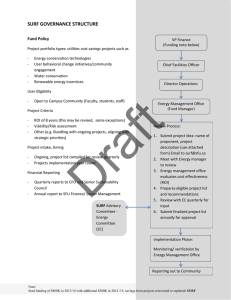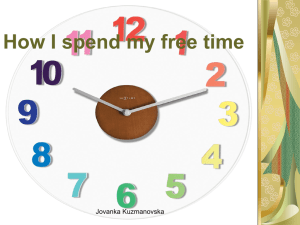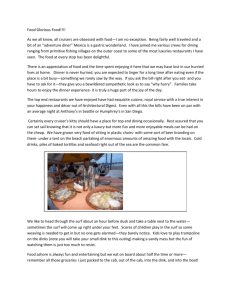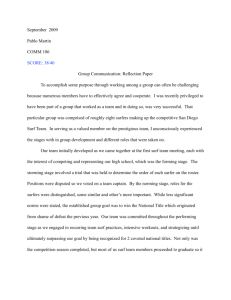Identification of Surf Breaks of National Significance Bailey Peryman Introduction
advertisement
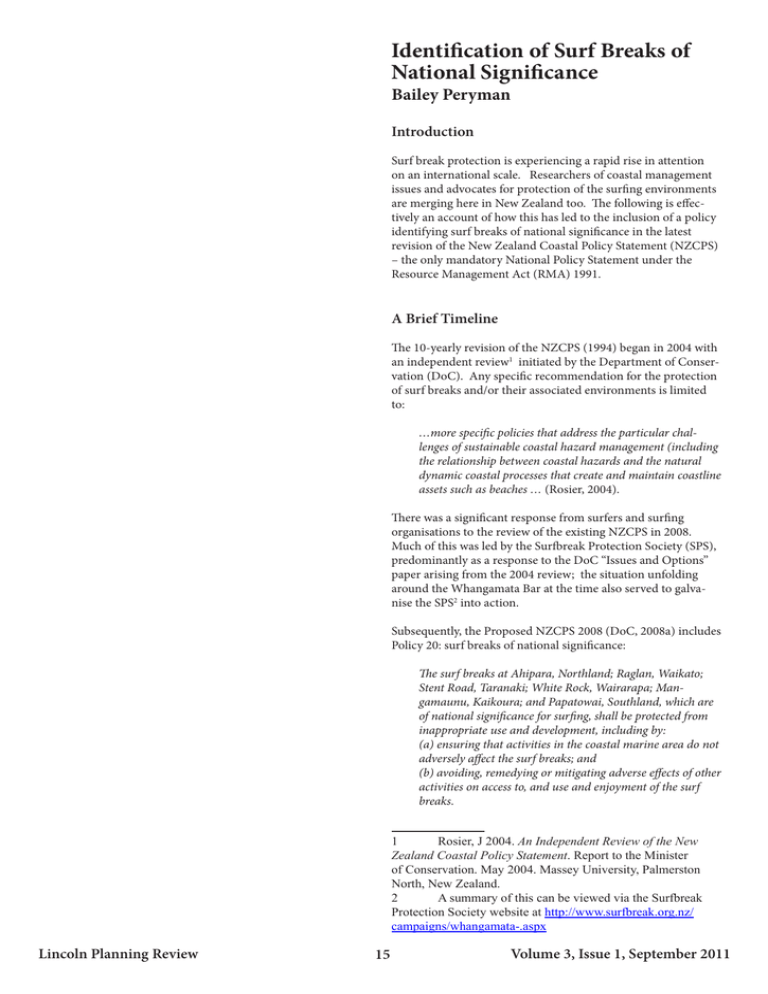
Identification of Surf Breaks of National Significance Bailey Peryman Introduction Surf break protection is experiencing a rapid rise in attention on an international scale. Researchers of coastal management issues and advocates for protection of the surfing environments are merging here in New Zealand too. The following is effectively an account of how this has led to the inclusion of a policy identifying surf breaks of national significance in the latest revision of the New Zealand Coastal Policy Statement (NZCPS) – the only mandatory National Policy Statement under the Resource Management Act (RMA) 1991. A Brief Timeline The 10-yearly revision of the NZCPS (1994) began in 2004 with an independent review1 initiated by the Department of Conservation (DoC). Any specific recommendation for the protection of surf breaks and/or their associated environments is limited to: …more specific policies that address the particular challenges of sustainable coastal hazard management (including the relationship between coastal hazards and the natural dynamic coastal processes that create and maintain coastline assets such as beaches … (Rosier, 2004). There was a significant response from surfers and surfing organisations to the review of the existing NZCPS in 2008. Much of this was led by the Surfbreak Protection Society (SPS), predominantly as a response to the DoC “Issues and Options” paper arising from the 2004 review; the situation unfolding around the Whangamata Bar at the time also served to galvanise the SPS2 into action. Subsequently, the Proposed NZCPS 2008 (DoC, 2008a) includes Policy 20: surf breaks of national significance: The surf breaks at Ahipara, Northland; Raglan, Waikato; Stent Road, Taranaki; White Rock, Wairarapa; Mangamaunu, Kaikoura; and Papatowai, Southland, which are of national significance for surfing, shall be protected from inappropriate use and development, including by: (a) ensuring that activities in the coastal marine area do not adversely affect the surf breaks; and (b) avoiding, remedying or mitigating adverse effects of other activities on access to, and use and enjoyment of the surf breaks. 1 Rosier, J 2004. An Independent Review of the New Zealand Coastal Policy Statement. Report to the Minister of Conservation. May 2004. Massey University, Palmerston North, New Zealand. 2 A summary of this can be viewed via the Surfbreak Protection Society website at http://www.surfbreak.org.nz/ campaigns/whangamata-.aspx Lincoln Planning Review 15 Volume 3, Issue 1, September 2011 Notably, the same Section 32 report recognises that protection of surf breaks “has not generally been provided for in planning documents, despite general directions in the Act and the 1994 NZCPS to protect natural features, processes, and amenity values” (DoC, 2008b, p. 46). Taranaki and Waikato Regional Councils are alone in creating provisions that directly identify surf breaks or recognise the importance of “surf zones” (SPS, 2006, p. 6); an example of what has to date been a predominantly voluntary and ad hoc process for protecting surf breaks within the context of the NZCPS 1994. A Board of Inquiry (BOI) was appointed to inquire into and report on the Proposed NZCPS. The BOI’s recommended NZCPS 2009 (DoC, 2009a) contains a new Policy 18 (replacing former Policy 20): All decision makers must recognise and protect surf breaks of national significance for surfing, including those listed in Schedule 2, by: (a) ensuring that activities in the coastal environment do not adversely affect the surf breaks; and (b) avoiding adverse effects of other activities on access to, and use and enjoyment of the surf breaks. This revision also includes a number of important definitions. Schedule 2 lists 17 surf breaks from around the country. The glossary of terms also contains some important definitions pertaining to surf breaks. These are both addressed in more detail below. After considerable delay, public availability of the recommended version only came about after a disgruntled BOI member leaked the document1 . Like a number of very public political debates surrounding our natural resources, the absence of this National-level policy statement creates issues of interpretation and coherence at the local government level. Policy 20: Surf Breaks of National Significance Justification for Policy 20 in the Section 32 report revolves around the national and international reputations of specific surf breaks in New Zealand, the significant benefits to people and communities provided by the natural features and process that create a surf break, and the potentially adverse effects of inappropriate use and development in the Coastal Marine Area (CMA) (DoC, 2008b). It references the case of the worldclass river mouth break of Mundaka in Northern Spain which was destroyed in 2005 by dredging in the area (DoC, 2008b, footnote 5 p. 46). This is a well-known case in the world of surf break protection and has particular relevance to the New Zealand context where similar alteration of sediment flows is arguably having an adverse effect on the Whangamata Bar2 . Stockroute, a Nationally Significant Surf Break at Wainui Beach, Gisborne . Photo taken by Bailey Peryman. The Section 32 report also recognises the economic significance of these surf breaks, as well as the importance of access, water quality and integrity of the natural processes that create a wave (DoC, 2008b). It is uncertain how the final list of surf breaks included in the original Policy 20 and the criteria for such was decided. The revised Policy 18: Surf Breaks of National Significance Much of the reasoning behind the changes leading to BOI recommendations and the new Policy 18 centres on four key points supported in the evidence and submissions on Policy 20 made by the team of coastal environment experts and advocates compiled by SPS (Skellern et al, 2009): This is significant in itself when the SPS itself does not know for sure how a policy protecting surf breaks came to be. 1 See the Scoop.co.nz press release titled: “Report of the Board of Inquiry into Coastal Policy” retrieved October 19, 2010 from http://www.scoop.co.nz/stories/PO1005/S00065. htm, or the SPS news release titled: “What happened to NZCPS Surfing Policy 20?” retrieved October 19, 2010 from http:// www.surfbreak.org.nz/news/what-happened-to-nzcps-surfingpolicy-20.aspx 2 See update posted on SPS website retrieved October 20, 2010 from http://www.surfbreak.org.nz/news/whangamatabar-update.aspx Lincoln Planning Review 16 1. The need for a policy specific to surf breaks in the NZCPS; 2. The lack of specificity (in Policy 20) required when identifying a surf break as more than just a geographical area (e.g. Ahipara, Northland) and therefore the need to establish substantive criteria that best reflect the “quality” of New Zealand’s surf breaks; 3. Establishing a working definition of the natural features and processes contributing to the presence of a surf break; and 4. The significance of surf breaks not initially recognised Volume 3, Issue 1, September 2011 as ‘world renowned’ or of ‘National Significance’ (e.g. regionally significant surf breaks). The BOI accepted the argument of a wide range of submitters, not just the SPS, which built on the findings if the initial Section 32 report mentioned above. Submissions to the BOI further established the importance of surf breaks as a finite natural resource and outstanding natural features in their own right. Surf breaks are of historical significance to Maori, as well as social, cultural and economic value to coastal communities in general. Pressures and activities in the coastal environment can and increasingly will lead to the damaging of surf breaks “scarce and vulnerable to development” (DoC, 2009b, p. 130). The identification of breaks in the revised policy is based primarily on the “Wavetrack method”: using breaks found in the Wavetrack New Zealand Surfing Guide (Morse & Brunskill 2004). This guide was accepted by the BOI as the most authoritative guide to New Zealand surf breaks (DoC, 2009b). The guide identifies 16 of the 470 listed breaks as having a 10 out of 10 “stoke”, or surf quality rating. The stoke rating “offers an accurate appraisal of each break’s potential when optimum conditions are present” (Morse & Brunskill 2004, p. 7). The surf break of Papatowai is included as an exception to the Wavetrack method that was protected under Policy 18. Although Papatowai has a rating of 8 on the stoke meter, it was protected for its growing international profile as a high performance big wave break. Thus, a total of 17 breaks are identified as being of national significance. The final Policy 16: Surf Breaks of National Significance The NZCPS 2010 was finally gazetted on November 4, 2010. This retained a stand-alone policy for surf breaks of national significance, including the key definitions and an unchanged schedule of surf breaks (see Appendix 1). The final Policy 16 “surf breaks of national significance” in the NZCPS 2010 reads relatively the same as the BOI recommendation above: Protect the surf breaks of national significance for surfing listed in Schedule 1, by: (a) ensuring that activities in the coastal environment do not adversely affect the surf breaks; and (b) avoiding adverse effects of other activities on access to, and use and enjoyment of the surf breaks. The breaks scheduled in Policy 16 can now be protected by the relevant local authorities. There are some inconsistencies evident in the naming and identification of the breaks and a change in wording truncating the opening sentence effectively renders this more conclusive than initially desired by key submitters. BOI recommendations accepted submissions in support of a policy open to further addition of yet to be identified breaks. Despite this, the policy is something of a milestone for surf break protection in the country and has received plaudits on an international scale (M. Skellern, personal communication, February 11, 2011). This method was addressed in detail in submissions made by the SPS and summarised well by evidence submitted by coastal planning expert Dr Hamish Rennie1. The fact that Policy 18 has been included in the recommended NZCPS underlines the merit of the submissions made to the BOI (M. Skellern, personal communication, August 23, 2010). The strength of these submissions also highlights the value of a more “bottomup” approach to policy and decision-making when a text as (relatively) simple as the Wavetrack guide can be accepted as a legitimate proxy in the absence of any other substantive criteria. The guide is the product of a pair of dedicated surfers working in conjunction with members of surfing communities from around the country. No small feat when dealing with the complex issue of interpreting “significance” within the context of the RMA. It is said “only a surfer knows the feeling…” and is therefore, arguably, the most qualified to define surf break quality. Surf Breaks in other NZCPS Policy A number of surf breaks were unsuccessfully argued for (e.g. St. Clair, Dunedin; Main Beach, Mt. Maunganui) as significant, either as national or regional “nursery breaks”2 , or for other reasons. However, the real teeth for surf break protection come through the inclusion of surf breaks as part of the natural character of the coastal environment (see Policy 13, DoC, 2010), and the recognition of seascapes as part of the natural features and natural landscapes of the coastal environment (see Policy 15, DoC, 2010,). I am conducting further studies in order to develop a robust methodology to guide local authorities in providing for surf breaks in response to the NZCPS 2010. The BOI also accepted the working definitions provided by SPS for: “Surf break”: A natural feature that is comprised of swell, currents, water levels, seabed morphology, and wind. The hydrodynamic character of the ocean (swell, currents and water levels) combines with seabed morphology and winds to give rise to a “surfable wave”. A surf break includes the “swell corridor” through which the swell travels, and the morphology of the seabed of that wave corridor, through 2 See evidence of Matthew Skellern, retrieved October 20, 2010 from http://www.doc.govt.nz/upload/documents/ getting-involved/consultations/current-consultations/nzcps/ evidence/133-nzcps-evidence-6-7.pdf 1 See evidence of Hamish Rennie, retrieved October 20, 2010 from http://www.doc.govt.nz/upload/documents/ getting-involved/consultations/current-consultations/nzcps/ evidence/133-nzcps-evidence-7-7.pdf Lincoln Planning Review to the point where waves created by the swell dissipate and become non-surfable. “Swell corridor”: means the region offshore of a surf break where ocean swell travels and transforms to a “surfable wave”. “Surfable wave”: means a wave that can be caught and ridden by a surfer. Surfable waves have a wave breaking point that peels along the unbroken wave crest so that the surfer is propelled laterally along the wave crest (DoC, 2009b, p.134). 17 Volume 3, Issue 1, September 2011 Arguments against Inclusion of a Stand-alone Surf Break Policy The jurisdiction of the RMA is limited to the 12 nautical mile limit of the CMA; this presents difficult questions for protecting the integrity of swell corridors stretching far beyond the seaward limit of the CMA. Notably, the BOI accepts the need to consider activities undertaken within the coastal environment, as opposed to just the CMA (DoC 2009b, p. 134), a subtle change in the wording of Policy 16 to cater for activities beyond the landward limit of the CMA. Another subtle change by the BOI is found in Policy 18(b), which states the adverse effects of activities shall be avoided, removing the “remedied or mitigated” as “there can be a major difference between avoiding and mitigating adverse effects” (DoC, 2009b, pp. 133-134). Most of the Councils question why surf breaks – and not recreational diving spots, subsistence fisheries, etc. – should be classed as a specific natural feature of our coastal environment that is worthy of protection. Selecting one coastal activity above others is seen as inappropriate in the context of the NZCPS. Values associated with surf breaks can be protected by Regional Policy Statements (RPSs) using a less directly surf break-focused form of policy1. Some Councils also expressed reservations about use of a national/regional/local hierarchy due to difficulty distinguishing cut off points for the appropriate or representative scale of surfing communities and their surf breaks (M. Langman, personal communication, September 28, 2010). Although a precedent has been set by the Taranaki Regional Council for including surf breaks in their RPS, there are also many questions around the form policy tools (e.g. RPS methods) might take for developing regional plans and regional coastal plans (M. Langman, personal communication, September 28, 2010), including complicated cross-over into the jurisdiction of local authorities for land-based activities. Perhaps this suggests a need to shift the focus of coastal planning towards integrated coastal management to meet the requirements of the comprehensive approach inherent in the NZCPS. Nevertheless, the complexity of coastal management issues is high when considering statutory management tools and provisions alone. This is illustrated by the figure in Appendix 2. The BOI agrees with the SPS, however, that: …the failure to identify [surf breaks] more specifically in the NZCPS will result in a less efficient, more ad hoc and arbitrary identification of nationally significant surf breaks through individual resource consent cases. We agree with Dr Rennie… that policy 20 should be retained because it... marks a significant step towards improving policy guidance to decision-makers on the sustainable management of rare, finite and threatened geographical features (see DoC, 2009b, pp. 133-134). This is based on the argument that the policy “specifically focuses on a component of the natural environment, as opposed to peoples’ activities, and addresses the need to protect that component from the negative effects of other human activities on it… and therefore retains an effects-based approach”2. It also supports general arguments for increased national guidance made by Dr Rosier in the 2004 review of the NZCPS and recognised in the Section 32 report on the Proposed NZCPS (mentioned above). Implications for Planners President Paul Shanks outlined in his evidence to the BOI, the language of surfers is hardly conducive to acceptance within the appropriate legal and planning frameworks3. Once “translated”, however, even some of the most colloquial of interpretations can be given legitimacy in the context of environmental law and science. This bodes well for a reorientation of the planning process to a more inclusive form of policy and decision-making; what is missing, arguably, is the methodology. Conclusions The new NZCPS presents a number of challenges for planners providing for surf breaks given that it is a new area of resource management. Local authorities are required to identify outstanding areas of natural character and natural landscapes (including seascapes) in planning provisions. Therefore, mapping the spatial extent and establishing baseline data for environmental monitoring of dynamic natural phenomena poses a significant challenge. Surf break protection is justifiable in an international context, demonstrated as a multi-billion dollar industry (see again the evidence of Paul Shanks – see footnote 10 below). The first World Surfing Reserve was recently inaugurated in Malibu, California, USA by the Save the Waves Coalition. Endorsed by a wide range of statutory and non-profit organisations, “World Surfing Reserves proactively identifies, designates and preserves outstanding waves, surf zones and their surrounding environments, around the world”4. A quick search on Google Earth reveals a number of breaks in New Zealand ear-marked for similar recognition. Similar progress in Australia has seen 11 1 The submission made by Northland Regional Council is an example of these two arguments. Retrieved October 20, 2010 from http://www.doc.govt.nz/upload/documents/gettinginvolved/consultations/current-consultations/nzcps/northlandregional-council-nzcps-403.pdf 2 Paragraphs 172-175 of evidence from Dr. Hamish Rennie, retrieved October 20, 2010 from http://www.doc.govt. nz/upload/documents/getting-involved/consultations/currentconsultations/nzcps/evidence/133-nzcps-evidence-7-7.pdf Lincoln Planning Review Personally, on a broader scale, I believe this entire process highlights the effectiveness of well-organised lobby groups in the RMA framework; à la the remarkable Fish & Game effort in securing the status of salmon and trout in the RMA. As SPS 3 See evidence retrieved October 20, 2010 from http:// www.doc.govt.nz/upload/documents/getting-involved/consultations/current-consultations/nzcps/evidence/133-nzcps-evidence-3-7.pdf 4 See the article titled: “Malibu becomes first World Surfing Reserve” retrieved October 20, 2010 from http://www. surfersvillage.com/surfing/49045/news.htm 18 Volume 3, Issue 1, September 2011 Rosier, J 2004. An Independent Review of the New Zealand Coastal Policy Statement. Report to the Minister of Conservation. May 2004. Massey University, Palmerston North, New Zealand. Retrieved October 21, 2010 from http://www.doc.govt.nz/upload/documents/ conservation/marine-and-coastal/coastal-management/ nzcps-review-2004.pdf “National Surfing Reserves” established across the country in coalition with Save the Waves1. The global community that is surfing is alive and well in New Zealand. A policy identifying surf breaks of national significance is testament to that fact. The complexity of issues surrounding the coastal environment and the interconnected nature of surfing and surfing culture as obviously both land and marine based lends weight to a more comprehensive and integrated approach to coastal zone management. The dynamism of the surfing industry and surfers alike are well-suited to accommodating such an approach. Skellern, M. (2010). (October) Future-proofing waves. KiwiSurf Magazine, pp. 50-53. Surfbreak Protection Society. (2006). Comments on the Dept of Conservation Issues and Options Paper – Review of the New Zealand Coastal Policy Statement. Retrieved October 20, 2010 from http://www.doc.govt.nz/upload/ documents/getting-involved/consultations/currentconsultations/nzcps/evidence/133-nzcps-exhibit-additional-2.pdf References Department of Conservation. (2008a). Proposed New Zealand Coastal Policy Statement 2008. Retrieved October 21, 2010 from http://www.doc.govt.nz/upload/documents/ getting-involved/consultations/current-consultations/ proposed-nzcps-2008-high-res.pdf Taranaki Regional Council. (2009). Regional Policy Statement for Taranaki. Retrieved October 21, 2010 from http:// www.trc.govt.nz/assets/Publications/policies-plans-strategies/regional-policy-statement/rps-full.PDF Department of Conservation. (2008b). Proposed New Zealand Coastal Policy Statement 2008: evaluation under section 32 of the Resource Management Act 1991. Wellington, New Zealand. Retrieved October 21, 2010 from http:// www.doc.govt.nz/upload/documents/getting-involved/ consultations/current-consultations/proposed-nzcpssection-32-report.pdf Appendix 1 Schedule 1: Surf breaks of national significance (DoC, 2010) Department of Conservation. (2009a). Proposed New Zealand Coastal Policy Statement 2008: Board of Inquiry Report and Recommendations. Volume 1: Findings, Recommendations and Recommended New Zealand Coastal Policy Statement 2009. Retrieved October 21, 2010 from http:// www.doc.govt.nz/upload/documents/getting-involved/ consultations/closed-consultations/nzcps/NZCPS-2008board-of-inquiry-vol-1.pdf Northland Peaks – Shipwreck Bay Peaks – Super tubes – Mukie 2 – Mukie 1 Waikato Manu Bay – Raglan Whale Bay – Raglan Indicators – Raglan Taranaki Department of Conservation. (2009b). Proposed New Zealand Coastal Policy Statement 2008: Board of Inquiry Report and Recommendations. Volume 2: Working Papers. Retrieved October 21, 2010 from http://www.doc.govt. nz/upload/documents/getting-involved/consultations/ closed-consultations/nzcps/NZCPS-2008-board-ofinquiry-vol-2.pdf Waiwhakaiho Stent Road – Backdoor Stent – Farmhouse Stent Gisborne Makorori Point – Centres Wainui – Stock Route – Pines – Whales The Island Coromandel Whangamata Bar Department of Conservation. (2010). New Zealand Coastal Policy Statement 2010. Retrieved November 21, 2010 from http://www.doc.govt.nz/upload/documents/conservation/marine-and-coastal/coastal-management/nzcoastal-policy-statement-2010.pdf Kaikoura Mangamaunu Meatworks Otago The Spit Karitane Murdering Bay Papatowai Morse, P. B. and Brunskill, P. (2004). Wavetrack New Zealand Surfing Guide. Greenroom Surf Media Limited: New Zealand. 1 For more on National Surfing Reserves in Australia see the website retrieved October 20, 2010 from http://www. surfingreserves.org/what-is-nsr.php Lincoln Planning Review 19 Volume 3, Issue 1, September 2011 Appendix 2 – Figure displaying applicable statutory provisions and instruments for Coastal Management Taken from Taranaki Regional Council document: “Regional Coastal Plan Review” retrieved October 20, 2010 from http://www.trc.govt.nz/assets/Publications/policies-plans-strategies/regional-plans-and-guides/regional-coastal-plan/ coastal-iwi09.pdf Coastal management is complex • ________-""".~.~Z=··O'""'~""=o·=UC -""".~.~Z=··O'""'~""=o·= UCIPCMOo/~ I PCMOo/~s~·"·cm"·o"tc_ s~ ·"·cm"·o " tc__________ S~&IT'Iin:$ IT'lirn (RegIonal Cru'lcIS) •__________ Ragona! POley St4l!& ~~~~~~~~c=o=~"_~ ______ _+ 81 8loseody Blosea.rly oseody A Act ct (MAFlMFlsh) (MAFlMFIsh) (MAF~Fish) 1993 [oJanl~ TJalSPQllA:1 L Mantine lJaniine TroflSpcul TJalS pollA:1. ki !MOT, !MOT, OT. J.ta) J.t-a) (pe:roarn (pe:ro'etnl u eJ.plorafrlnobil uplorafrlnobil :sPII planniag) (pe:rol!:u'!l plora6ln.ijJ :!(ill :sP11plannil'loJ RegionalCtJilS!al Regional Coaslal Plans (Rt:giooal tReyioMI Carvl) Car d ) !.!arine I.IarineReser IAarine Reser.esAct(DOC) Reser.e$ .. ~Act(DOC) Act (DOC) Di5ticl Disric\ P\w; Disrit;l P;w; POOS (DiWie! (D (Di~rict i$lrid Cou1ols) Cou1cils) CoI.ncils) fI.ari1e ~·.ame Mmmals ~'.am~ Ma r:lmal~ Prole&ton Mammal~ ProlEcto n ([JOCl Prolecton ([JOC1 Crown MnerelsAcl Mner£lsAcl rt Nauf~ r.lau~CBI 200 Mile Unt Un! lint '~7 (Mi1i3terof (Mni3terof Enefgy) Enefgy) 1 1112 12 Nautca NautC81: Mile Urn.! Urn.1 Me;n "'o~n Hgh W3;Qr Wa:Gr Spr,ng;: Spnngs SPf,~ (high ti:IG) ti:lo) Coastal C<Jastal Morine Marine Nc:a NCD Inia1d InianlJ Inlllfl'J limil olthe of the «Ja$tal coa ~~1 erl' envlOllmeot. envlOllment. lIonment. Detelmi1ed Oetelmi1ed Detelmiled ona on a case Irt by ca:;e t:<t:;e~~ ba:s~ Coail<il Erl'ltoom&1l! Tar1!a'al Sea I caring for our environment Lincoln Planning Review 20 Volume 3, Issue 1, September 2011
